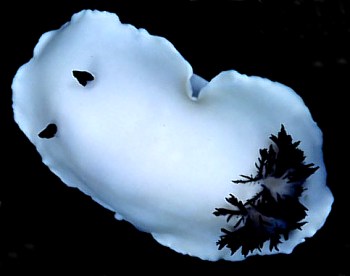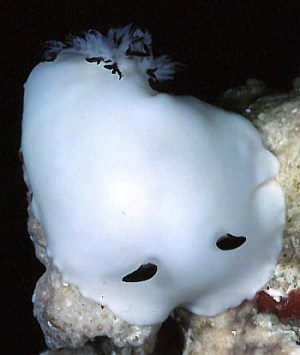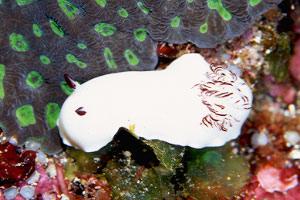

Peltodoris fellowsi
Kay & Young, 1969
Order: NUDIBRANCHIA
Suborder: DORIDINA
Superfamily: EUDORIDOIDEA
Family: Dorididae
DISTRIBUTION
Originally thought to be an Hawaiian endemic, but records from Pitcairn Ids (Edmunds & Preece, 1996) and records presented in the Forum from Japan and Lifou, New Caledonia, suggest a wider western Pacific distribution.
PHOTO
Lifou, Loyalty Ids, November 2000. 54mm long alive. PHOTOS: Bill Rudman.
Mantle and foot are white. The rhinophore lamellae and gill leaflets are black. In the original description the rhinophore stalks and gill rachids are described as red-brown while in the specimens illustrated here from Lifou they are translucent white. The mantle is relatively firm or rigid and the dorsal surface is covered with fine granules.
References:
• Kay, E.A. & Young, D.K. (1969) The Doridacea (Opisthobranchia: Mollusca) of the Hawaiian Islands. Pacific Science, 23(2): 172-231.
• Edmunds, M. & R.C. Preece, 1996. A collection of opisthobranch molluscs from the Pitcairn Islands. Journal of Conchology, 35: 407-421.
Rudman, W.B., 2001 (January 23) Peltodoris fellowsi Kay & Young, 1969. [In] Sea Slug Forum. Australian Museum, Sydney. Available from http://www.seaslugforum.net/find/peltfell
Related messages
Distribution of Peltodoris fellowsi
February 1, 2001
From: Richard Willan
Bill,
Concerning the message on P. fellowsi. Just to set the record straight; Peltodoris fellowsi has not been considered an Hawaiian endemic species for some years. Edmunds & Preece (1996: 413) recorded it from Henderson Island which is part of the Pitcairn group of islands at the easternmost limit of the Pacific Plate. Their specimens were collected intertidally during the Sir Peter Scott Commemorative Expedition in 1991.
Reference:
Edmunds, M. & R.C. Preece, 1996. A collection of opisthobranch molluscs from the Pitcairn Islands. Journal of Conchology, 35: 407-421.
Cheers,
Richard
Richard.Willan@nt.gov.au
Willan, R.C, 2001 (Feb 1) Distribution of Peltodoris fellowsi. [Message in] Sea Slug Forum. Australian Museum, Sydney. Available from http://www.seaslugforum.net/find/3675Thanks Richard,
Your welcome correction only goes to confirm what I said to Steve Wheeler in a recent message. Mistakes don't last long on the Forum. There is indeed rigorous, and almost instantaneous, peer review.
Best wishes,
Bill
Peltodoris fellowsi from Japan
January 30, 2001
From: Hideyuki Takasu

Dear Dr. Rudman
This animal is similar to Peltodoris fellowsi Kay & Young,1969. This animal is found sometimes in Hachijo Island in Japan. But that animal is endemic to Hawaii. Could you please identify this ?
Information about the photograph:
2 June,1996, Depth: 20m, Water temperature: 21 degrees centigrade
Sincerely,
Hideyuki Takasu
http://homepage2.nifty.com/nudibranchs/.htm
h.takasu@nifty.com
Takasu, H. , 2001 (Jan 30) Peltodoris fellowsi from Japan. [Message in] Sea Slug Forum. Australian Museum, Sydney. Available from http://www.seaslugforum.net/find/3622Dear Hideyuki,
This is a very interesting find. I couldn't be totally sure until its anatomy was studied, but externally it certainly looks like Peltodoris fellowsi. As you say it has been considered an Hawaiian endemic until now, but your find suggests differently.
By coincidence we found the same species at Lifou during the Lifou 2000 expedition last November, suggesting that it has a wide distribution throughout the West Pacific.
Best wishes,
Bill Rudman
Peltodoris fellowsi from Lifou
January 30, 2001
From: Bill Rudman


To accompany Hideyuki Takasu's message on Peltodoris fellowsi from Japan, here are a couple of photos of it from Lifou, Loyalty Ids., east of New Caledonia. I have not as yet had a chance to examine its anatomy, but externally it fits Kay & Young's original description well, except that they describe the rhinophore stalks and gill rachids to be red-brown whereas in the Lifou specimens they are translucent white.
Best wishes,
Bill Rudman
